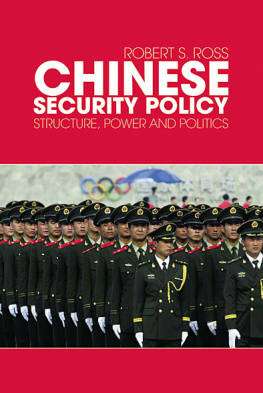STRATEGIC THINKING IN 3D
RELATED TITLES FROM POTOMAC BOOKS
Fighting Talk: Forty Maxims on War, Peace, and Strategy
Colin S. Gray
National Security Dilemmas: Challenges and Opportunities
Colin S. Gray
Military Strategy: Principles, Practices, and Historical Perspectives
John M. Collins
STRATEGIC THINKING IN 3D
A Guide for National Security, Foreign Policy, and Business Professionals
ROSS HARRISON

Copyright 2013 by Ross Harrison
All rights reserved
Potomac Books is an imprint of the University of Nebraska Press
Library of Congress Cataloging-in-Publication Data
Harrison, Ross, 1953
Strategic thinking in 3D : a guide for national security, foreign policy, and business professionals / Ross Harrison. First edition.
p. cm
Includes bibliographical references and index.
ISBN 978-1-59797-706-7 (hbk. : alk. paper)
ISBN 978-1-59797-807-1 (electronic)
1. StrategyCase studies. 2. Strategic culture. 3. Strategic planning. 4. Success in business. 5. Qaida (Organization) 6. International relations. I. Title.
U162.H296 2013
658.4012dc23
2013001937
Printed in the United States of America on acid-free paper that meets the American National Standards Institute Z39-48 Standard.
Potomac Books
22841 Quicksilver Drive
Dulles, Virginia 20166
First Edition
10 9 8 7 6 5 4 3 2 1
This book is dedicated to my late father, Roland Harrison, who gave me the room to think strategically;
To my mentor and teacher, the late Richard Cottam, who introduced me to the rigors and mysteries of strategy;
And to my loving wife, Mahnaz M. Harrison, whose unflagging love and support helped give me the courage to write this book.
CONTENTS
PREFACE
Why write a book on strategy when so many have already been written? One motive for writing this book came from the reactions I received from people when I told them I was working on the topic of strategy. They invariably would ask, What type of strategy? Are you working on military, foreign policy, or business strategy? When I said I was writing about the concept of strategy, rather than any particular type, eyes would invariably glaze over. I concluded that in most peoples minds, strategy is inextricably linked to particular professions, and that it is seldom thought of as a subject worthy of study in its own right. Strategic Thinking in 3D came from a belief that the right way to study strategy is to focus first on the broad principles of strategy, followed by an application of these principles to the peculiarities of individual professions.
Another motivation came from the belief that strategy had to be rescued as a concept. Like the Buddhist tale in which several blind men feel an elephant and, depending on which part of the animal each of them feels, go on to describe it as something completely different, strategy means different things to different people. of using the strategy terminology loosely to describe very different types of activity is that the concept has become diffused and devoid of any real clarity.
There are multiple reasons why this divide on strategy has occurred. One is the historical evolution of the concept. The notion of strategy has its antecedents in, and evolved with, the military profession. Starting with Sun Tzuand later expanded by Carl von Clausewitz and other classical theoriststhe concept of strategy took shape according to the logics of war and battle. While these classical theorists did see military strategy as serving broader political ends, their analyses were largely confined to the pursuit of military victory. Nonetheless, the concept of strategy evolved over time, extending beyond the battlefield and into the diplomatic and political arenas. In the diplomatic and political spheres, strategy took on a different form, expanding to a focus on a broad range of strategic assets including, but not limited to, instruments of force.
Business strategy has also had its own unique historical trajectory. Even though business professionals in competitive situations have traditionally borrowed insights from military strategists, the effects of globalizing industries have forced executives to expand their strategic vision beyond the narrow business-as-war paradigm to include something approximating the more expansive notion of grand strategy. While this trend might portend eventual convergence between the business and foreign policy notions of strategy, there is little evidence today to suggest that differences in how strategy is conceptualized by national security and business professionals have been significantly narrowed.
Another factor contributing to the fuzziness of the concept is the casual way strategy has become part of the modern parlance. It is often used to describe something as prosaic as a good idea or as mundane as a simple plan of action. The strategy-making process involves creativity, innovation, and change, while strategic planning tends to be less about strategy and more about operations. But in some organizations these operations get confused with, or even crowd out, the higher-level function of strategy making.
The lack of a coherent concept of strategy also constitutes a problem because most of the significant strategic challenges we face today straddle political, commercial, and military boundaries. The challenges we faced in Iraq and continue to face in Afghanistan are examples of strategic situations that defy categorization, as they do not fit neatly into the sectors of military, diplomatic, or business. The strategic problems we have faced in these two countries, and the challenges we are likely to face in the future, are multifaceted. They require better interagency coordination between the military, diplomatic, and development arms of the U.S. government, as well as between governments, NGOs, and the private sector. In other words, complex, multifaceted problems have outstripped the capacity of sector specific strategies and cry out for integrated, cross-sector strategic responses. But the lack of unanimity when it comes to strategy, coupled with conceptual sloppiness, make communication and strategic coordination across these sectors inefficient, unwieldy, and sometimes impossible. As the complexity of strategic problems grows, and challenges from nontraditional actors become more prevalent, the need for more robust cross-sector strategic approaches also grows.
Another problem created by strategic disarray has less to do with the dynamics of cooperation between the business and governmental sectors, and more to do with the nature of conflict in todays international system. The adversaries faced by governments now include, but are not limited to, traditional nation-states. Conventional strategic approaches are inadequate for governments confronting challenges from non-state actors like al-Qaeda, Somali pirates, or empowered individuals or organizations like WikiLeaks. The strategic responses that worked for contending with strong nation-state rivals are also ineffective in dealing with the asymmetric challenges that come from failing or failed states. Similarly, global corporations find little help from traditional business strategies to guide them as they face intensified, and sometimes adversarial, interactions with governments and NGOs.
The last pragmatic reason that sector-specific strategies are inadequate has to do with the growing trend toward professionals migrating between the public and private sectors over the duration of their careers. Since sector-specific approaches to strategy are not particularly portable, this creates a large learning curve for those individuals who want to cross over to another field. These individuals need a general grounding in strategy that is transferable between the private and public sectors. While someone expertly schooled in strategy may be able to extract lessons from one field and apply them later to another, the lack of a common framework makes this difficult for most people.
Next page











